Besides the hairline, male pattern baldness often becomes most visible in hair loss on the crown. For many this leads to large, hard-to-conceal bald areas. Fortunately, the Dr UGraft advanced FUE crown hair transplant procedure offers a safe, easy solution for crown hair restoration in men and women suffering from crown hair loss.
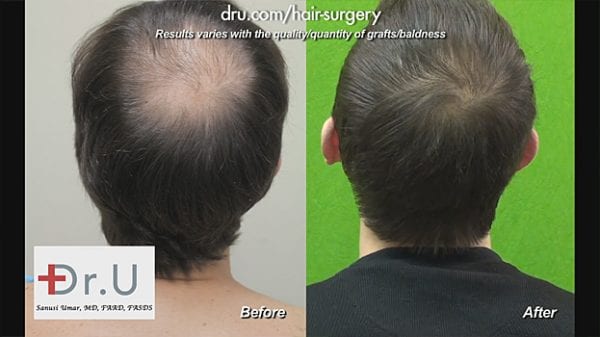
What Causes Hair Loss in the Crown of Your Head?
What is crown hair loss? Many people disagree about the exact location of the crown of the head. Some consider it the apex of the skull, while others call it the area behind the apex of the skull. Regardless of the exact location, hair loss at the crown continues to plague many people. Pattern baldness, or androgenic alopecia, specifically causes acute crown hair loss. Men with pattern baldness typically begin to see hair loss at the crown first. A genetic condition, pattern baldness results in permanent hair loss. Losing hair at the crown can affect men and women, causing cosmetic issues for both. Crown hair loss in women can prove just as extreme as it does in men.
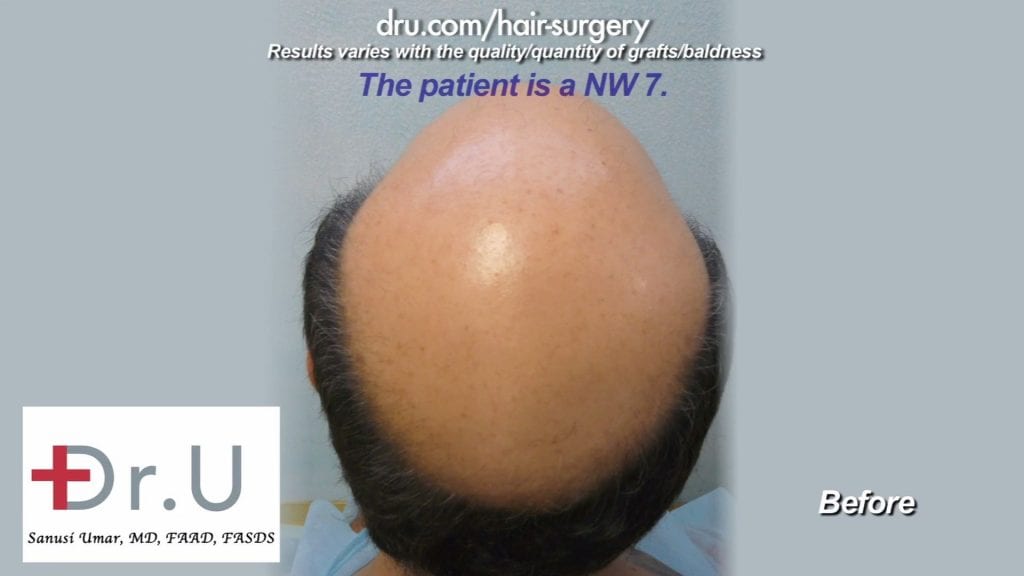
Two different genes cause hair loss, allowing pattern baldness to pass down through generations. Pattern baldness gets passed down through the X-chromosome, making it a hereditary condition. The genes cause weak androgen receptors, allowing hair follicles to fall susceptible to the shrinking effects of DHT. Though DHT, or Dihydrotestosterone, naturally exists as a hormone on the scalp, in those with the genetic predisposition of pattern baldness DHT minimizes hair follicles. Thus hair loss occurs in various degrees in various locations, such as the hairline, crown, and mid-top.
Methods of Crown Hair Restoration
Many solutions ranging from nonsurgical hair restoration options to hair transplants exist for those with hair loss at the crown. Men and women who wish to conceal their hair loss have several options:
- Hair pieces
- Medications: Minoxidil and Finasteride
- Hair Transplantation: Strip surgery Vs follicular unit extraction.
Hair pieces, such as wigs and other hair attachments, offer only concealment. While nonsurgical, hair pieces have major shortcomings. Apart from the negative psychological consequences of using toupees, weather elements such as wind and rain can affect hair pieces, making them a limited solution.
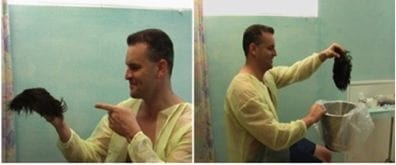
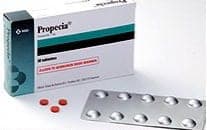
FDA-approved topical drugs like minoxidil (Rogaine) as well as Finasteride (Propecia) promote hair growth. However, patients need to begin the drug quickly after noticing hair loss in order to maximize effectiveness. Established slick baldness would typically not respond.
Generally, medications tend to work better for crown and vertex hair loss than frontal and hairline loss. Moreover, drugs can have side effects, and have not shown effectiveness in all cases.
Crown Hair Transplant: Follicular Unit Strip Surgery vs. Dr.UGraft FUE
The most popular choices of hair restoration today include follicular unit strip surgery (FUSS) and the follicular Unit Extraction ( FUE ) procedure. FUSS involves a strip harvest, in which a surgeon removes a linear strip of hair near the mid-rear scalp as a donor supply. FUSS is invasive, often resulting in harsh hairlines and scarring. Additionally, FUSS can only utilize head hair as the donor source, which limits the supply. For this reason, most doctors would not want to restore the crown, preferring instead to emphasize covering the frontal balding areas. FUSS hair transplants therefore result in the front restored to a fuller look while the crown balding is left untouched or barely covered.
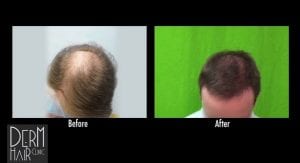
Why Dr.UGraft is the Gold Standard for Crown Hair Transplants
Unlike FUSS, FUE extracts individual hair follicles rather than strip harvesting. The surgeon extracts hair follicles directly from donor regions one by one, making the process less invasive. However, because basic FUE depends solely on head donor supply, basic FUE has the same limitations as FUSS. Enter the Dr UGraft Advanced FUE method. Dr.UGraft is an advanced form of regular FUE that enables the expansion of the donor pool by effectively utilizing non-head hair. This ability makes crown hair restoration using Dr.UGraft the leading solution for curing baldness.
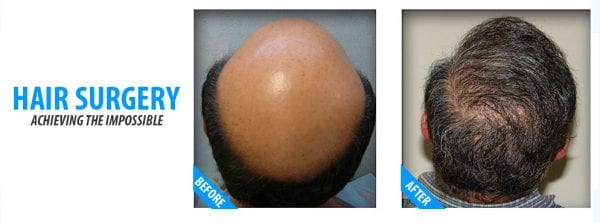
Because it transcends the donor supply limitations of FUSS and regular FUE, Dr.UGraft with Dr Umar can take on the business of restoring hair to the crown without restriction. With Dr.UGraft approach, crown hair thinning can end and hair can be restored to the entire scalp including the crown, top and front for high density. The Dr.UGraft procedure is also equipped to treat female hair loss at the crown of the head.
VIDEO: Crown Hair Restoration In Severe Baldness using Dr.UGraft
When deciding which crown hair loss restoration solution to choose, patients should consider two factors:
- Size of the crown
- Crown whorl location and orientation
The Size of the Crown
The size of the crown shows the area of miniaturized or absent bad hair follicles. In many cases, the crown is the largest bald area for men. The spherical shape of the crown can make baldness look deceptively large. The convex shape reflects more light giving the illusion of worse emptiness. Thus the crown area requires more grafts to fill baldness than the typical hairline. The expanded donor supply courtesy of Dr.UGraft method enables full hair restoration to even the largest and baldest crowns.
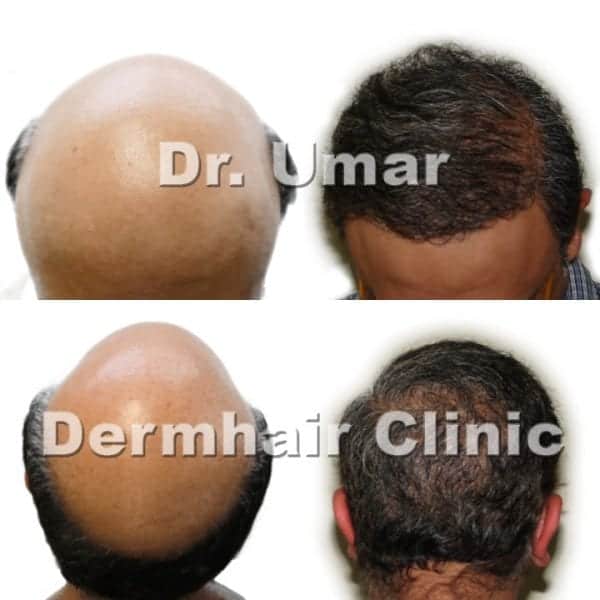
Crown Whorl
Crown whorl often makes hair restoration more complex. The crown spirals outward around a center point like the stars of a galaxy, causing hair to grow in multiple directions. For example, hair on the sides of the head angles in different directions. Some patients even have two whorls on their head. The crown whorl’s location varies, not always landing in the center of the head. Additionally, the orientation of the whorl could run clockwise or anticlockwise. If there are two whorls, they would tend to spiral in opposite directions (for example, one would run anticlockwise while the other would run clockwise). The direction of the whorl dictates the wave direction of the hair in the entire scalp.
The center of the whorl typically consists of finer hair that gets coarser as it moves away from the whorl center. For the most natural look, a hair surgeon should mimic this arrangement. Dr UGraft procedure can use finer hairs from the nape, around the ears, and the body in the middle of the crown to impart that natural softness, making the procedure especially well suited for a crown hair transplant.
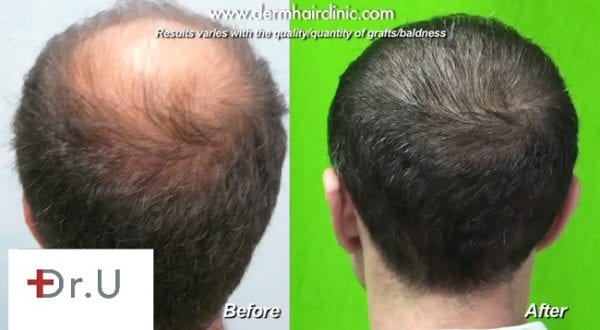

Crown Hair Transplant Repair
The crown may become disfigured and scarred because of past surgical misadventures or as a result of traumatic accidents.
Scalp Reduction Crown Slot Deformity Correction Using Dr.UGraft By Dr U
The antiquated hair restoration procedure called scalp reduction often causes scalp deformity. In the scalp reduction process, a surgeon cuts away portions of the bald scalp and sews the resulting wound close together, resulting in an overall reduction of the original bald scalp surfaces. Many doctors have abandoned this once-popular procedure because of its many complications, including deformation of the crown called a “Slot Deformity”. In slot deformity of the crown, the crown becomes oblong, oval, or even linear in shape instead of the normal circular dome. The deformity of the crown shape also results in more chaotic hair angulation emanating outwardly from the margins of the deformed crown.
Scalp Reduction Crown Slot Deformity Correction Using Dr UGraft By Dr U: Before and After Photos
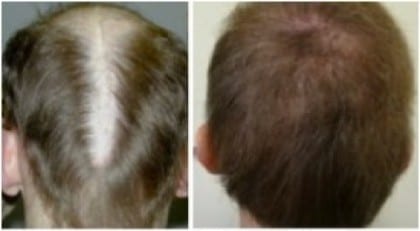
VIDEO RESULTS: Scalp Restoration Using Dr.UGraft By Dr U
Los Angeles Patient receives complete crown restoration and fuller hairline and temples
No Description
Misaligned Crown Hair Transplant repair Using Dr.UGraft By Dr U
A novice hair restoration doctor can have difficulty restoring hair to the crown, and may end up creating an odd hair pattern instead of a normal-looking crown whorl. The photo below shows a patient who had such an experience before coming to Dr. Umar for repair. The crown hair transplant photo on left below shows a row of hair placed in an arc shape that looks very odd. The patient wore a hairpiece for over a decade to hide the odd crown hair pattern. Dr. Umar utilized Dr.UGraft method, transplanting head, beard, and body hair to repair the situation as depicted in the right photo below:
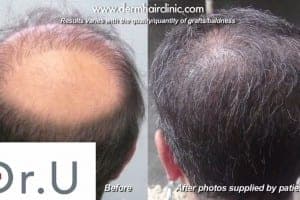
Finding the Right Crown Restoration Surgeon
Finding the right surgeon to facilitate crown hair loss regrowth is key to having successful crown hair transplant results. Patients should inquire about visual documentation in order to find the right surgeon. Videos and photos provide examples of what certain surgeons can do. Patients should look for cases similar to their own situation to ensure a surgeon has successfully restored hair in patients suffering similar hair loss. Patients with significant hair loss or those destined to become significantly bald should look for a doctor skilled in Dr.UGraft methods that can utilize head and body hair in combination to rebuild a full and credible looking crown of hair.
Looking for a credible looking crown hair restoration using Dr.UGraft? Get a free hair consultation by completing our online consultation form!
Crown Hair Transplant Frequently Asked Questions:
Why Did Another Clinic Tell Me To Restore My Front and Hairline First And Leave My Crown Bald?
All clinics practicing FUSS (Strip Surgery) or Basic FUE (Conventional FUE) that relies solely on head donor, would tell you this. They do so because their methods can only hope for 5000 – 8000 grafts from any individual over a lifetime since that is all that head donors can typically yield over a lifetime. For this reason, in individuals that go on to become very bald, this number would be insufficient to meet their needs credibly. This is the reason they prioritize restoration of the front at the expense of the crown. However, Dr U with his Dr UGraft advanced FUE system expands donor supply by adding beard and body hair to the donor pool. For this reason, using this system, there is no need to neglect the crown any longer. Using Dr UGraft even very severely bald individuals are easily restored completely.
How is Dr.UGraft FUE procedure for crown hair thinning better than other hair loss at the crown restoration surgeries?
Other hair restoration heads rely solely on hair transplanted from other areas of the head, which can vastly limit the donor supply. Dr.UGraft FUE procedure, by contrast, enables the expansion of the donor pool by its ability to utilize hairs from the beard, and body. This means, the patient is not likely to run out donor supply even if crown restoration is given as big enough a priority as the rest of the more anteriorily disposed bald scalp areas. Patients who undergo crown restoration using Dr.UGraft can enjoy restored density of growth with hair that looks totally natural.
Are hair transplants effective as crown hair loss treatment?
Because Dr.UGraft FUE crown hair transplant procedure utilizes individual hair follicles, it offers success whether other procedures and methods cannot. Dr.UGraft FUE uses a special tool created and patented by Dr. Umar himself called the Dr.UPunch. This needle-like tool excises hair follicles from the skin and stores them in a special solution to keep them alive. In the case of crown restoration, Dr.UGraft offers particular success thanks to its ability to transplant body hair. With this expanded donor pool, Dr. Umar can perform crown hair loss treatment to natural thickness and density with totally natural-looking results.
What is a typical crown hair transplant timeline? Does Dr. Umar perform hair restoration in a single session?
Each case varies, depending on the level of baldness a patient experiences. More severe baldness and crown hair loss situations can require multiple surgical procedures spread out over a period of time to ensure best results and avoid complications. Before performing any surgical procedure, Dr. Umar consults and advises patients on what to expect, and develops a treatment plan with the patient. This treatment plan addresses issues like number of procedures and expectations for each specific case.
What does crown hair transplant cost?
The price of the procedure varies from case to case depending on the extensiveness of the hair loss. Patients who would like to know a cost estimate should consult with Dr. Umar.
If you’re interested in more information about crown restoration with the Dr. U Hair Clinic, you can send your questions to Dr. U by clicking the button below:
